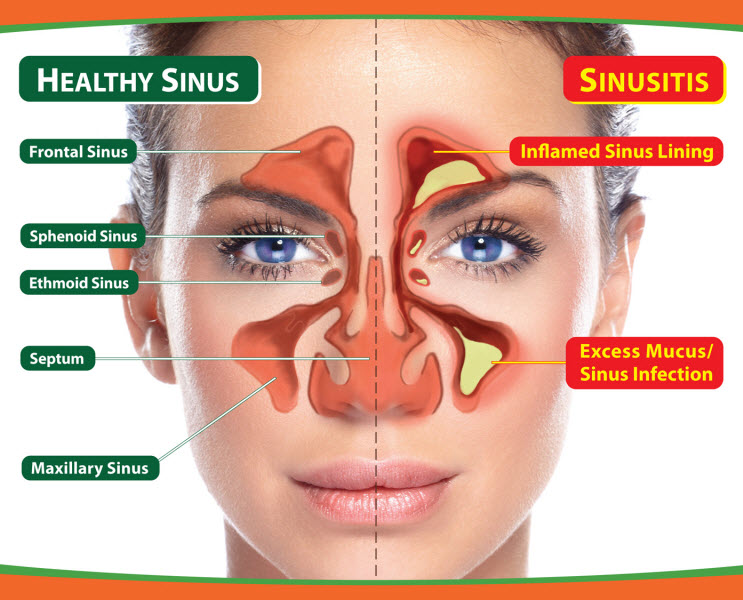What Is Sinusitis?

Your nose is stuffy. You have thick, yellowish mucus. You’re coughing, and you feel tired and achy. You think that you have a cold. You take medicines to relieve your symptoms, but they don’t help. When you also get a terrible headache, you finally drag yourself to the doctor. After listening to your history of symptoms and examining your face and forehead, the doctor says you have sinusitis.

Sinusitis means your sinuses are infected or inflamed. Your sinuses are hollow air spaces within the bones surrounding the nose. They produce mucus, which drains into the nose. If your nose is swollen, this can block the sinuses and cause pain and infection.
Sinusitis can be acute, lasting for less than four weeks, or chronic, lasting much longer. Acute sinusitis often starts as a cold, which then turns into a bacterial infection. Allergies, pollutants, nasal problems and certain diseases can also cause sinusitis.
Symptoms of sinusitis can include fever, weakness, fatigue, cough and congestion. There may also be mucus drainage in the back of the throat, called postnasal drip. Treatments include antibiotics, decongestants and pain relievers. Using heat pads on the inflamed area, saline nasal sprays and vaporizers can also help.

Your lungs are a pair of large organs in your chest. They are part of your respiratory system.
Treatment
After diagnosing sinusitis and identifying a possible cause, your healthcare professional can suggest various treatments.
Acute sinusitis
If you have acute sinusitis, your healthcare professional may recommend the following:
Antibiotics to control a bacterial infection, if present
Pain relievers to reduce any pain
Decongestants (medicines that shrink the swollen membranes in the nose and make it easier to breathe)
Even if you have acute sinusitis, your healthcare professional may choose not to use an antibiotic because many cases of acute sinusitis will end on their own. However, if you do not feel better after a few days, you should contact your healthcare professional again.
Follow your healthcare professional's instruction on how to use over-the-counter or prescription decongestant nose drops and sprays. You should use these medicines for only a few days, as longer term use can lead to even more congestion and swelling of your nasal passages.
If you suffer from nasal allergies, such as hay fever, along with sinusitis, your healthcare professional may recommend medicine to control your allergies. This may include a nasal steroid spray that reduces the swelling around the sinus passages and allows the sinuses to drain.
If you have asthma and then get sinusitis, your asthma may worsen. You should contact your healthcare professional, who may change your asthma treatment.
Chronic rhinosinusitis
Healthcare professionals often find it difficult to treat chronic rhinosinusitis successfully. They have two options to offer patients: medicine and surgery.
Medicine
Nasal steroid sprays are helpful for many people, but most people still do not get full relief of symptoms with these medicines.
A long course of antibiotics is occasionally recommended by physicians, but results from clinical research do not support this kind of antibiotic use.
Saline (saltwater) washes or saline nasal sprays can be helpful in chronic rhinosinusitis because they remove thick secretions and allow the sinuses to drain.
Oral steroids, such as prednisone, may be prescribed for severe chronic rhinosinusitis. However, oral steroids are powerful medicines with significant side effects, and these medicines typically are prescribed when other medicines have failed.
Research is needed to develop new, more effective treatments.
Surgery
When medicine fails, surgery may be the only alternative for treating chronic rhinosinusitis. The goal of surgery is to improve sinus drainage and reduce blockage of the nasal passages. Nasal surgery usually is performed to accomplish the following:
Enlarge the natural openings of the sinuses
Remove nasal polyps
Correct significant structural problems inside the nose and the sinuses if they contribute to sinus obstruction
Although most people have fewer symptoms and a better quality of life after surgery, problems can reoccur, sometimes even after a short period of time.
In children, problems can sometimes be eliminated by removing the adenoids. These gland-like tissues, located high in the throat behind and above the roof of the mouth, can obstruct the nasal passages.